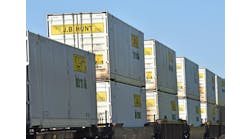U.S. consumers will get 8.6 billion packages delivered domestically this year, according to projections from SJ Consulting Group. As e-commerce growth continues with no signs of tapering off, the profound dependency on logistics and industry developments to support this boom is all the more apparent. In the months to come, we can expect to see certain trends in the logistics sector that are a byproduct of this new normal, or potentially a negative side effect.
Increased Visibility
As retailers focus on improving the post-sale experience as a tactic to drive loyalty and gain market share, they will continue to invest in better tracking systems to give consumers up-to-the-minute visibility into the location of their packages. UPS already offers a “Follow My Delivery” feature for UPS My Choice customers, with which you can see the truck carrying your package on a live map with updates every few minutes. This type of tracking will continue to become the norm, with carriers investing in advanced GPS technology so all parties will be able to see exactly where a package is en route to the final delivery location.
Tracking technology is equally important in the B2B sector. In order to maintain an optimal level of inventory that helps to reduce out-of-stock situations and minimize expenses related to supply storage, advanced supply chains are already built around just-in-time (JIT) logistics to provide an extra layer of planning and efficiency. All successful business must now ensure that they are always up-to-date on the location and ETA of their shipments via state-of-the-art tracking systems—not only to remain competitive, but also to lower operations costs.
Price Competition
Identifying the rise in e-commerce purchases as an opportunity within the logistics arena, big technology companies, such as Uber, Amazon and Convoy, have entered the industry with existing scale, money and fleets at the ready. These companies can use their truckload business as a loss-leader, offering low pricing in order to gain market share. We can expect to see an increase in price competition in 2020 among the tech-focused truckload brokerage businesses, which will in turn cut into margins for traditional freight brokers.
While a trend towards cost-cutting is clear, the question is whether it’s sustainable. It is unlikely that drivers would accept a decrease in wages, and given that there is already a shortage of drivers, this means the carrier or broker will take the margin hit. Large carrier fleets such as Covenant, Swift and US Xpress have all increased driver pay rates over the last two years to ensure they maintain their driver loyalty, but if smaller carriers or single-operator trucking companies are forced to continuously accept lower paying shipments as a result of price competition, their drivers could move on to larger fleets or completely exit the driver workforce.
We have already seen Celadon Group, a truckload carrier with 2,500 truck drivers, filing for bankruptcy in December 2019. While their drivers will most likely be absorbed by other large carriers, this will most likely be used as a push to maintain or increase rates from large asset fleets.
On the flip side, if we do see an “Uber effect” on small truck fleets and lower market pricing results in a reduction in driver salaries as well, we may see more drivers leaving the industry. Given the limited workforce available already, the race to the bottom pricing model Uber and Amazon are leading will most likely hurt the industry as a whole. As the U.S. economy continues to drive increased cargo demand, the industry can’t afford to lose the people moving it.
Rising Operations Costs
In contrast to this push across the industry for a reduction in carrier rates, the costs to operate a trucking company will continue to increase in 2020, particularly due to two key factors: evolving state and federal regulations, and pressure to reduce the environmental impact of the industry.
The Department of Transportation is always looking to ensure U.S. roads are safe, and as such, the introduction of laws like the electronic logging device (ELD) mandate require trucking companies to continually invest in new technology or new assets in order to remain compliant. The ELD mandate has not only required trucking companies to invest in logging devices, but has also reduced the amount of work a single driver was doing prior to the mandate going into effect, which in turn increases costs for operators.
As states develop or expand upon national DOT initiatives for safety and environmental laws, trucking companies who wish to operate across the entire U.S. must ensure compliance with states with the most stringent requirements. Higher operating costs often lead to higher prices for customers, so it will be interesting to see how the competing trends of lower pricing and higher operating costs battle it out over the course of the year.
White Glove Logistics Growth
While we will continue to see growth in parcel package deliveries in 2020, we will see an even bigger spike in online sales of items requiring white glove logistics and services, as consumer online spending continues to grow across more product categories. Due to this new trend in e-commerce for objects that cannot be shipped via parcel or general freight, there will be an increasing need for automated fulfillment solutions that service those items.
Since consumers have been conditioned to expect that their online purchases will be delivered quickly and efficiently, this will continue to put pressure on sellers of oversized, fragile, or high-value items to invest in logistics and operations to cater to this growing audience.
Darren Dodson is head of operations and logistics at ARTA, a provider of technology and fulfillment solutions for global white glove logistics.



